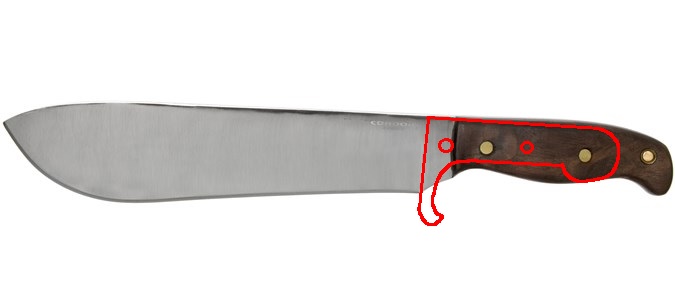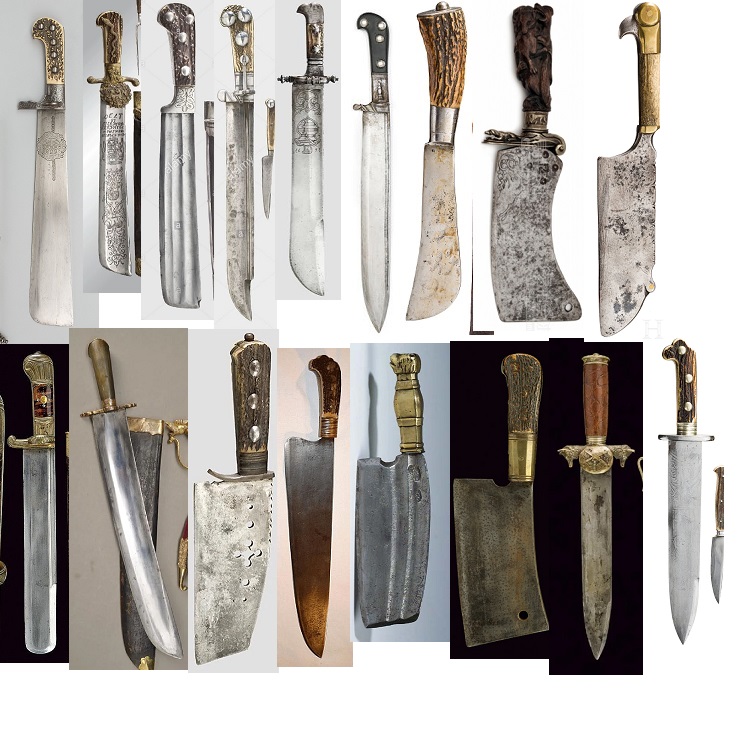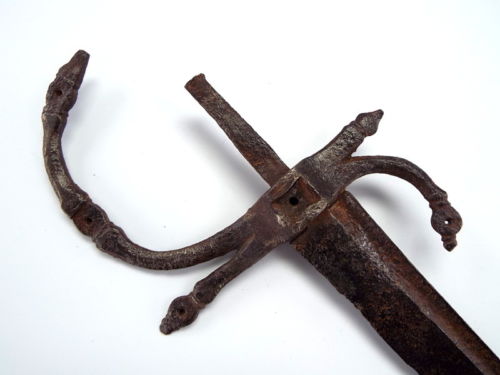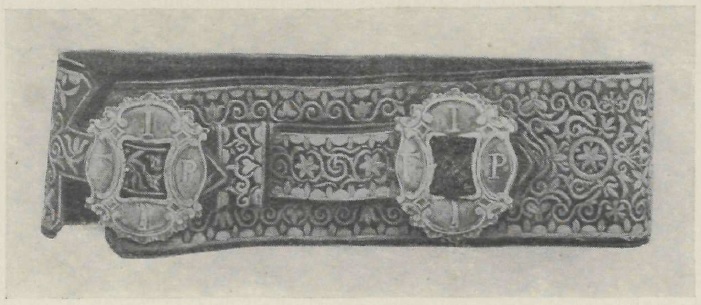| Author |
Message |
|
Dan D'Silva
|
 Posted: Sun 12 Apr, 2020 7:50 am Post subject: 17th-c. German hunting knife conversion Posted: Sun 12 Apr, 2020 7:50 am Post subject: 17th-c. German hunting knife conversion |
 |
|
Thought I'd share this little project. It's made from a "Spanish mini-belduque" that can be acquired from several sellers.

The wood faux-antler scales aren't entirely convincing in person, but, eh.
So, I was wondering if anyone could recommend what I might use for the fork, bodkin and cleaver. For the latter I had the idea of perhaps using a machete in the 12-inch range. It's my understanding that a meat cleaver should have a very heavy blade for its length.
 Attachment: 442.07 KB Attachment: 442.07 KB
Full-size pic if you don't want to wade through the whole spiel at my blog to get to it. [ Download ]
|
|
  |
 |
|
Dan D'Silva
|
 Posted: Sun 31 May, 2020 5:45 am Post subject: Posted: Sun 31 May, 2020 5:45 am Post subject: |
 |
|
How about a Condor Ironpath? Rather pricey, yes, but about the closest thing I've found to an original in a functional knife. Just have to defer ordering for a while.
The other thing I've considered is a frontier rifleman's knife blade from Crazy Crow. It may not look like a typical cleaver but you'll note that there is one in my collage (upper row, fourth from the right) that has a similar shape. It's cheap enough that I would just go for it, except I don't know whether the blade's weight and balance would be suitable for a meat cleaver, and also whether it would be hard enough. Crazy Crow says outright that they don't know the exact alloys or hardness range of their 5450 line of blades, and several of us have observed that this one as well as their Scottish dirk blade (part of the same line) are tempered pretty soft.
 Attachment: 19.76 KB Attachment: 19.76 KB

If the ricasso is too anachronistic, I could reshape the tang and drill extra rivet holes so the guard sits over it.
 Attachment: 174.86 KB Attachment: 174.86 KB

|
|
  |
 |
|
Eric W. Norenberg
|
 Posted: Sun 31 May, 2020 9:34 am Post subject: Posted: Sun 31 May, 2020 9:34 am Post subject: |
 |
|
Hi Dan,
How about this Devil’s Edge single edged qama, might be a good donor blade for the cleaver:
http://kultofathena.com/product.asp?item=AK017
I have no idea of the blades quality, haven’t picked one up myself, but the dimensions and overall profile might be close to your needs.
|
|
  |
 |
|
Dan D'Silva
|
 Posted: Mon 01 Jun, 2020 5:19 am Post subject: Posted: Mon 01 Jun, 2020 5:19 am Post subject: |
 |
|
|
Thanks -- dunno how that one slipped my notice but it does look like a better option than nearly any other so far.
|
|
  |
 |
|
Dan D'Silva
|
 Posted: Sun 21 Feb, 2021 9:53 am Post subject: Posted: Sun 21 Feb, 2021 9:53 am Post subject: |
 |
|
|
Heya. I'm making final plans for the cleaver hilt. I'm gonna do the bolsters in nickel silver to match the by-knife, but I was pondering making the side ring from mild steel or brass because I'm finding nickel silver a major pain to bend (it doesn't anneal anywhere near as easily, either by air-cooling or quenching). Would the combination of nickel bolsters and a steel or brass side ring look too strange, in your opinion?
|
|
  |
 |
|
Dan D'Silva
|
 Posted: Wed 12 Oct, 2022 3:39 am Post subject: Posted: Wed 12 Oct, 2022 3:39 am Post subject: |
 |
|
Hi again. Well, this is going in a somewhat different direction. I've decided to furnish the set with oak grips and steel hardware, which looks to be working out much easier; I took Radovan's recommendation of using furniture tack heads for the washers, and yesterday I stumbled across Lukas' rugger WIP thread which gives a clear idea of how to assemble the bolsters and side ring rivet without the ring being able to rotate in its pin hole after it's peened. I'm giving up on finding an awl -- though if I ever do stumble across one, incorporating it would only require a rebuild of the cleaver scabbard. And I'll be reusing the original knife for some other project. I did find a much nicer one, though.

(The lighter-colored areas of the grips are where I sanded them to fit perfectly flush with the tang edges and then had to re-round them. They'll look better once varnished.)
Recently I started to think I'd like a matching sword, like in this set: https://collections.royalarmouries.org/object/rac-object-151
There don't seem to be any off-the-shelf blades available with a slab tang like the trousse components have, but I did find a historical example that appears to have had a hidden tang (see attached). I'd been thinking of rehilting a Deepeeka English half-basket hanger as the originals all seem to have had straight blades and the narrow fuller and needle point are within the range of historical examples, but then the question is whether the hilt will be a convincing match with the rest of the set without attempting complicated frame-handle construction.
With a hidden tang the washers would be purely decorative, except in the unlikely case that the tang is wide enough to drill pin holes through. In the absence of pin holes, I would have to leave the shanks on the tacks, shorten them and reshape the points, which would be tedious, and they won't have the mechanical security of a rivet peened over them at both ends.
 Attachment: 19.34 KB Attachment: 19.34 KB

Was once on eBay, I have no idea how long ago nor whether there were any other pics available.
|
|
  |
 |
|
Mark Millman
|
 Posted: Wed 12 Oct, 2022 1:00 pm Post subject: Posted: Wed 12 Oct, 2022 1:00 pm Post subject: |
 |
|
Dear Dan D'Silva,
| On Wednesday 12 October 2022, you wrote: | | With a hidden tang the washers would be purely decorative, except in the unlikely case that the tang is wide enough to drill pin holes through. In the absence of pin holes, I would have to leave the shanks on the tacks, shorten them and reshape the points, which would be tedious, and they won't have the mechanical security of a rivet peened over them at both ends. |
Have you thought about trying to find tacks with longer shanks that you could drive against the tang and force them to turn back into the wood of the grip, clenching them in place? It's a fairly common historical solution--admittedly, not often for knife or sword grips--but may not work with short-shanked tacks or ones that have comparatively hard shanks. Of course, if the tang is wide enough that you can easily hit it with the tacks' shanks, it's probably wide enough to drill holes through.
Best,
Mark Millman
|
|
  |
 |
|
Dan D'Silva
|
 Posted: Thu 13 Oct, 2022 5:00 am Post subject: Posted: Thu 13 Oct, 2022 5:00 am Post subject: |
 |
|
That sounds like a great idea. I think the shanks on the furniture tacks are long enough unless the grip is thicker than I expect it to be. It may take some experimenting to find out if grinding them to a taper and/or annealing them is necessary.
I don't trust my competency to align pin holes in the grip for a hidden tang, even if it is wide enough. Maybe if I went through with a frame handle... but I'm getting ahead of myself. Deepeeka tang widths vary a lot, no way of knowing unless and until I actually get one.
|
|
  |
 |
|
Dan D'Silva
|
 Posted: Mon 02 Jan, 2023 8:30 am Post subject: Posted: Mon 02 Jan, 2023 8:30 am Post subject: |
 |
|
The hardware for the cleaver is all done and I cut the scales to rough shape this morning. But I'm starting to come around to the view that this blade is a bit too light to qualify as a cleaver, especially now I've had to leave out the protruding finger guard -- aside from the ring rivet and washers it's now looking mostly like a generic Hauswehr.

Maybe at some future date I'll commission a proper cleaver blade and an awl.
|
|
  |
 |
|
Dan D'Silva
|
 Posted: Mon 19 Jun, 2023 5:36 pm Post subject: Posted: Mon 19 Jun, 2023 5:36 pm Post subject: |
 |
|
Scales shaped, varnished and pinned. Now there's only the scabbard to do (although that's a whole other project by itself).


|
|
  |
 |
|
Dan D'Silva
|
 Posted: Fri 23 Jun, 2023 9:44 am Post subject: Posted: Fri 23 Jun, 2023 9:44 am Post subject: |
 |
|
By the way, anyone know what kind of belt/baldric was used with this class of hunting gear? I've checked Dean but the earliest belt he shows is turn of the 18th century, and I'm not having any luck elsewhere.
 Attachment: 71.83 KB Attachment: 71.83 KB

|
|
  |
 |
|
Dan D'Silva
|
 Posted: Sat 16 Mar, 2024 5:35 pm Post subject: Posted: Sat 16 Mar, 2024 5:35 pm Post subject: |
 |
|
Any evidence for German hunting swords with clipped points in the late 17th century, sort of like a latter-day langes messer? I'm down to just a couple off-the-shelf options for a project blade and want to know whether I should rule out one of them.
Edit: I found a belt that I think could be a model for this type. It's a bit early, but the buckle is roughly the same shape as later ones:
Leibgurt / Schwedler und Leibgurt
|
|
  |
 |
|
Dan D'Silva
|
|
  |
 |
|
Ryan S.
|
 Posted: Tue 16 Apr, 2024 10:31 am Post subject: Posted: Tue 16 Apr, 2024 10:31 am Post subject: |
 |
|
|
I don’t think that hunting swords had clipped points. A lot of online pictures don’t show the points. Hirschfängers were dedicated thrusting weapons, although there were similar curved swords called Jagdplauten. What purpose would this type of knife have and would a clipped point make sense?
|
|
  |
 |
|
Dan D'Silva
|
 Posted: Thu 18 Apr, 2024 5:11 pm Post subject: Posted: Thu 18 Apr, 2024 5:11 pm Post subject: |
 |
|
I don't really know much about the actual function of hunting swords at this specific time and place, but I assume they fit into the general ostensible purpose of a hunting sword to finish off immobilized game animals. A needle point would seem to make the most sense for this. I guess a clipped point would also work, but if I understand it correctly, it's a compromise intended to make a primarily slicing or slashing blade more capable at thrusting. I don't imagine hunters were often slashing at live game, and slicing would have been for after the critter was dead, at which point they'd use knives, not swords.
I'd never heard of Jagdplauten before, but the results I get from Google show short curved cuttoes similar to the ones used further west in the 18th century. Is that what you mean?
|
|
  |
 |
|
Ryan S.
|
 Posted: Sat 20 Apr, 2024 4:34 am Post subject: Posted: Sat 20 Apr, 2024 4:34 am Post subject: |
 |
|
Pretty much most of my knowledge on the topic comes from the website of Deutschen Historischen Museums. They say that the Hirschfänger and Jagdplaute developed from the earlier Jagdschwert. They also refer to the Jagdplaute as a hunting saber, which is the main difference. Sometimes the curved Jagdplaute is called a Hirschfänger, and possibly could be used as one, though it was meant to cut the leg tendons of a deer.
A curved cuttoe is, as far as I can tell the equivalent of a Jagdplaute. Both Hirschfänger and Jagdplaute served as the mark of a hunter or forester and their legal right to hunt deer. I believe in later years, this symbolic use was more important than the original use, especially as hunting methods changed.
https://www.dhm.de/archiv/magazine/jagdwaffen/HTMLs/schwerter_hirschfaenger.html
|
|
  |
 |
|
Dan D'Silva
|
 Posted: Sat 20 Apr, 2024 8:55 am Post subject: Posted: Sat 20 Apr, 2024 8:55 am Post subject: |
 |
|
| Ryan S. wrote: | | Sometimes the curved Jagdplaute is called a Hirschfänger, and possibly could be used as one, though it was meant to cut the leg tendons of a deer. |
I wouldn't have thought of that...
Okay, the Bowie blade design is off the table. Here's a draft for one using a dagger blade and a knucklebow. The counterguard would have a ring; really the ring should be welded or riveted to the quillon block, but for various reasons I'm not sure that would work in this case.
 Attachment: 20.21 KB Attachment: 20.21 KB

 Attachment: 504.06 KB Attachment: 504.06 KB
[ Download ]
|
|
  |
 |
|
|

